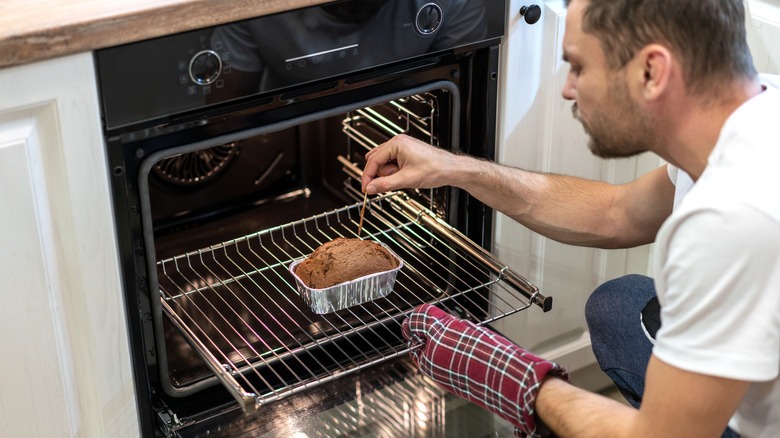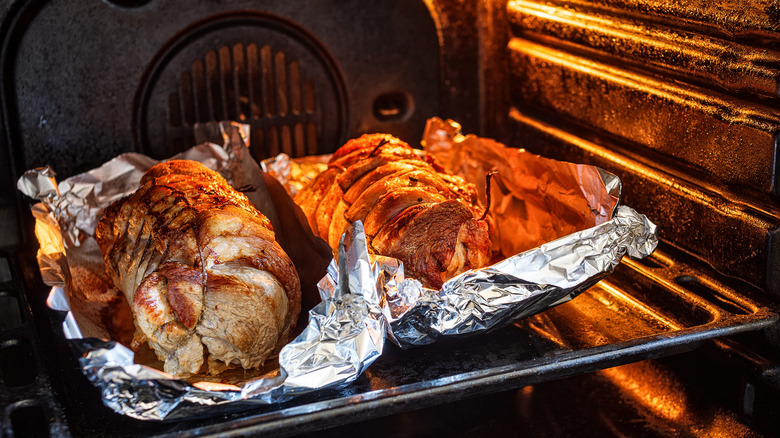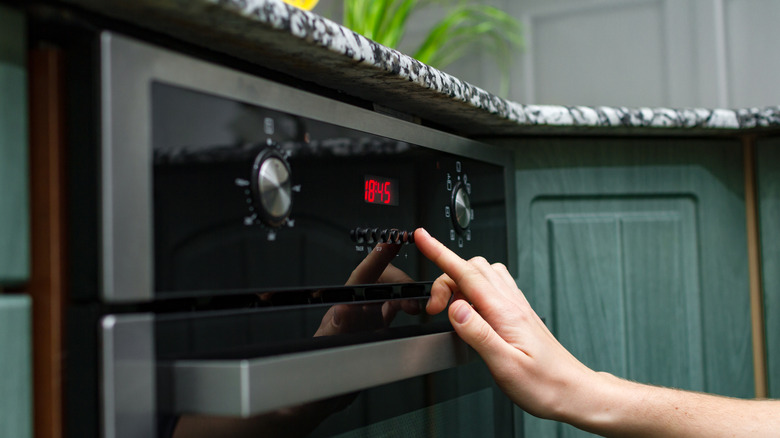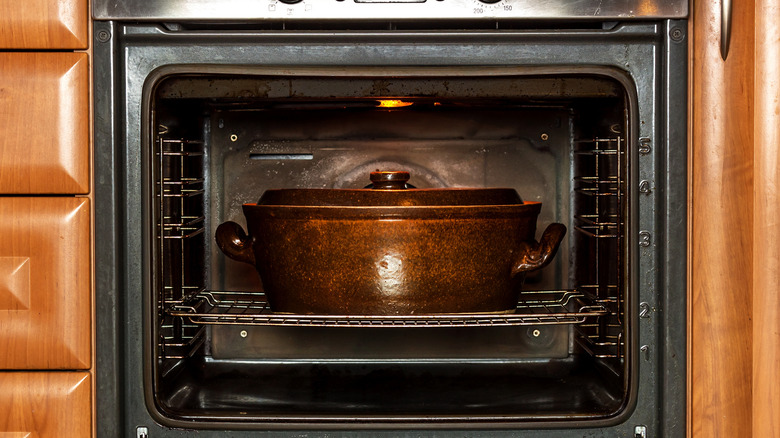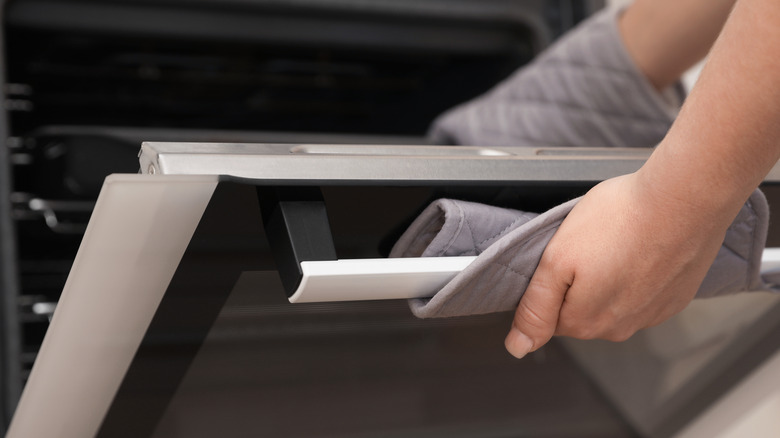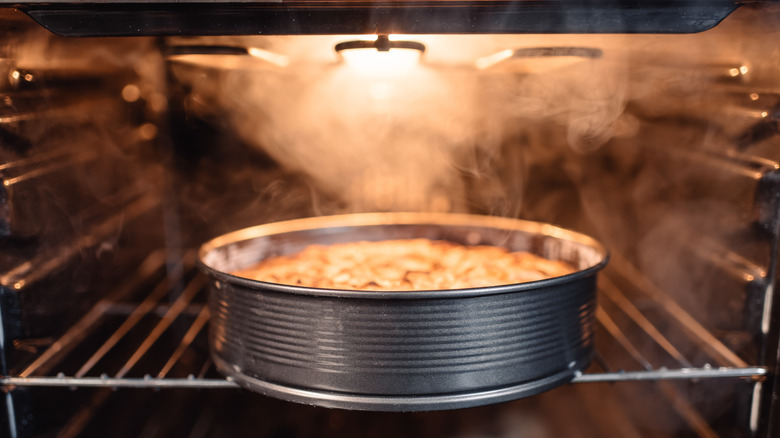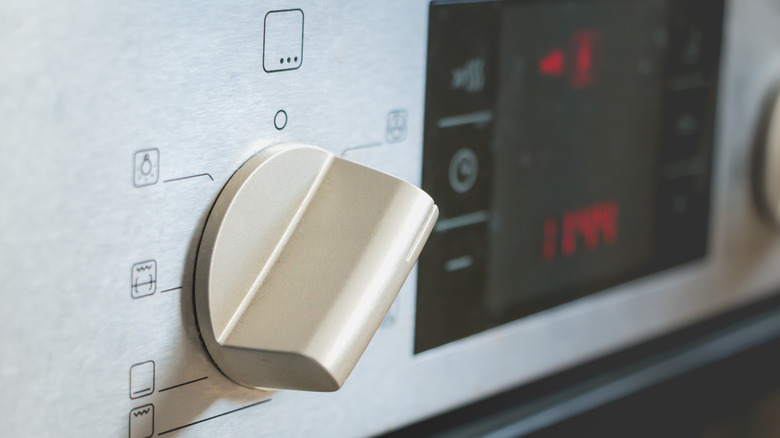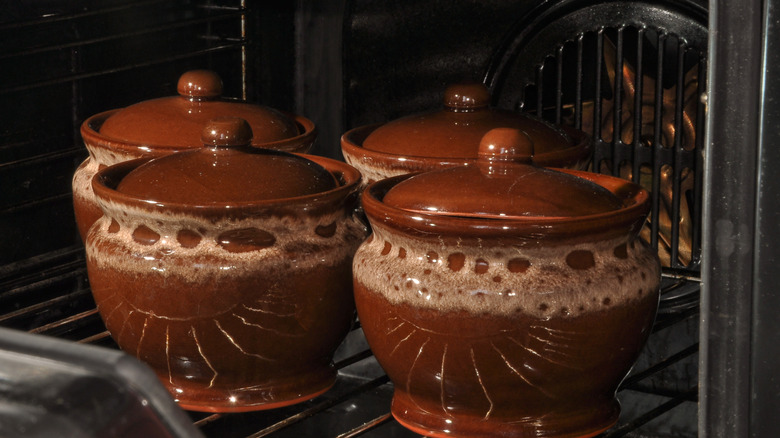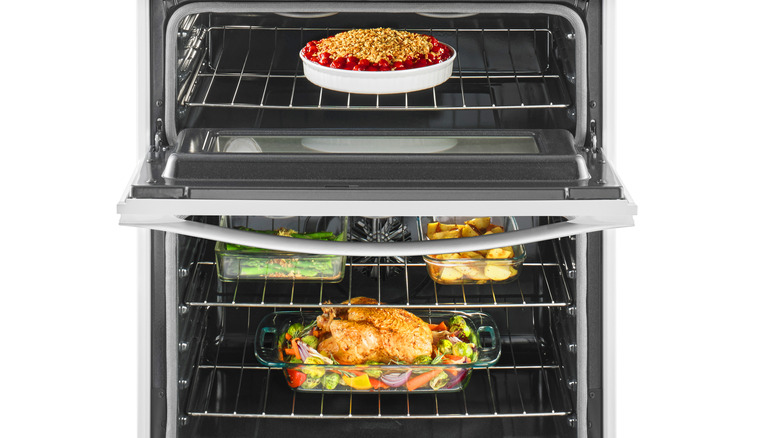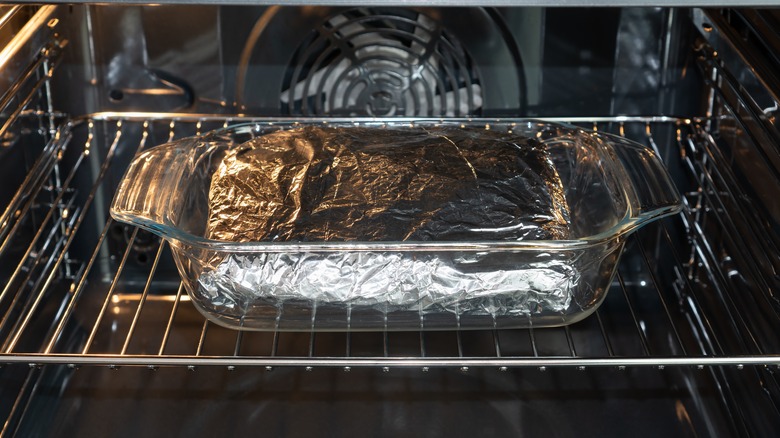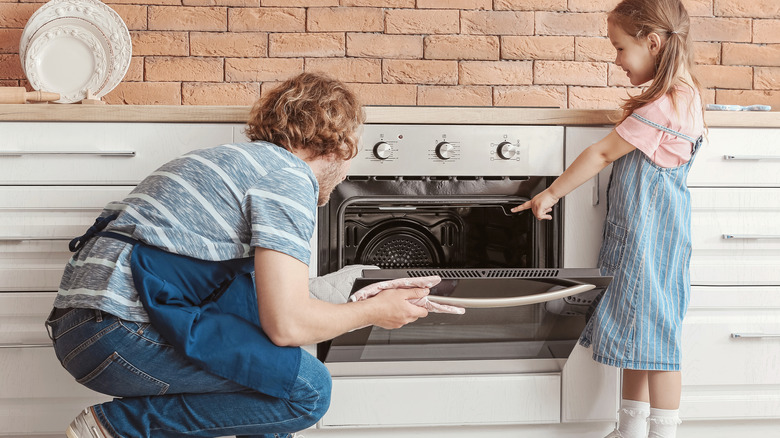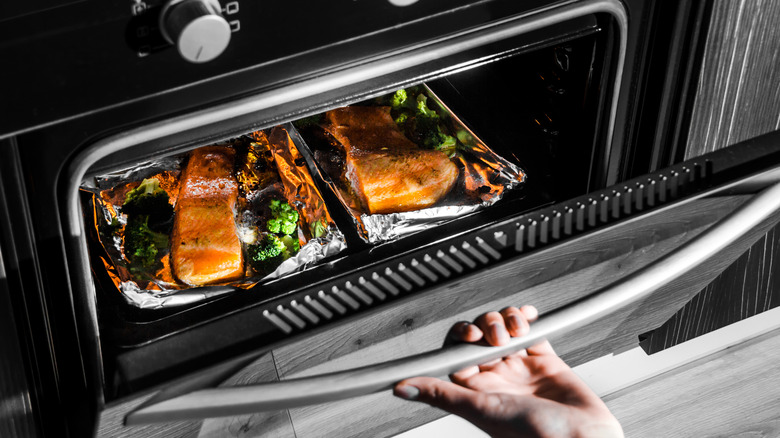13 Mistakes You're Probably Making With Your Convection Oven
If you don't know your convection oven like the back of your hand, it might give you some trouble. And if you can't differentiate between a conventional and a convection oven, you're surely not alone. After all, their names start with the same few letters, and they essentially serve the same purpose of cooking food. Not to mention, they look awfully similar too. The easiest way to differentiate between the two is the fan in the convection oven promotes hot air movement and more consistent cooking.
Although both types of ovens cook various foods and baked goods, a convection oven works differently because of its extra part. Therefore, you must get to know your convection oven, especially if you are only experienced with using its counterpart. Unfortunately, certain practices that are harmless with standard ovens can be disastrous if used with convection-styled appliances. So, before you throw that layer of foil over your casserole or use a deep-dish pan, you might want to learn why it's a bad idea to do so. In order to have the smoothest experience possible when you use the appliance, avoid the following common errors with convection ovens.
1. Setting the temperature too high
Generally, recipes are written with the assumption that the food will be cooked in a conventional oven. So, if you follow the recipe to a tee when using a convection oven, it can cause your food to burn. For example, although your baked chicken recipe might suggest you set the oven to 425 degrees Fahrenheit, you put the meat at risk when you don't adjust the temperature. The rule of thumb for baking with convection ovens is to lower the temperature by 25 degrees. This recommendation applies to any food you make, whether it's baked goods or full-on entrées.
The temperature in a convection oven affects food differently than in a conventional oven thanks to the built-in fan. The air constantly moves around all sides of the food, so it heats much faster. If you are still new to using a convection oven, write yourself reminders in your favorite recipes to decrease the temperature so it doesn't slip your mind and negatively impact your food.
2. Failing to adjust the cooking time
Even if you change the oven's temperature, it doesn't mean you are necessarily safe from overcooking your food. You might not have the best outcome if you don't closely monitor it or modify the cooking time. To reiterate, if a recipe requires you to cook fish for 15 minutes, it likely means it takes 15 minutes to cook in a standard oven, not a convection-style one. Hence, don't wait for the total amount of time to pass before you give it a peek. Otherwise, you might end up with dry food.
After all, the constantly flowing air heats the food from all angles, instead of just the bottom or top of the pan getting hot from the heating elements, which can dry out foods more quickly. The best thing to do is check the grub once roughly 75% of the suggested time has passed, just to be safe. Although this is a learning curve at first, the fact that these types of ovens cook faster is one benefit that is appealing to many folks.
3. Using the wrong type of pans
Believe it or not, the type of pan you use in your oven might be the biggest downfall. Let's just cut to the chase and say the worst kind of pans to use in your convection oven are deep pans with high edges. Firstly, they restrict airflow, which is counter-productive. Since the air doesn't access the food as it should, it doesn't cook uniformly. Also, you might cause a blunder when you use dark-colored pans because they take on heat significantly differently than lighter ones. Convection ovens are already hot enough as it is, so when you have a pan that absorbs heat faster, it makes the bottom of the food scorch.
Glass pans might not be ideal, either, for the opposite reason. Convection ovens cook food quicker, but glass dishes take a while to heat up. Before the materials come up to temperature, it might hinder the heat from getting through to the food. You can use these pans if they are your only option; just be cautious. Low sides are essential to look for in cookware when you use a convection oven. Of course, perforated pans work well, too, for certain foods, and they promote excellent airflow in the oven.
4. Not rotating your pans
Although convection ovens aren't supposed to have hot spots, they sometimes still do because not every appliance is flawless. You make a mistake when you assume you are safe from this issue just because you have this type of oven. When you don't pay close attention to the food cooking, it might brown in certain spots more than others. Depending on the type of dish you make, you might need to rotate the pan halfway through the cooking process.
Fortunately, most convection ovens have a glass window to look through and examine the food without the need to open the door. If you look inside and notice that the front row of cookies is noticeably darker than the other rows, abstain from waiting it out to see if the rest magically catches up to speed. Instead, don't be afraid to spin the tray around to even things out.
5. Not cooking with steam when needed
Particular food, like artisan bread, doesn't turn out as successful when you don't involve steam in the baking process. If you bake it in a dry oven, the beautiful golden crust doesn't correctly form, and the inner part of the food dries out because of the absent humidity. Nobody wants the inside of their sourdough loaf to be brittle, so don't overlook this important factor. Aside from bread, other foods you should cook with steam include cheesecakes, flan, hard-boiled eggs, and grains because the hot steam prevents interior moisture from escaping.
Luckily, certain ovens have steam settings, which make it easy for you because all you have to do is activate the correct mode. Check out your oven's written manual; if the appliance doesn't have that neat feature, there is another way to introduce steam to the environment. Add hot water to a shallow pan and place it on the bottom shelf, which provides a similar effect. Don't fill the water too high so that the pan is not safe to handle or too low so that it all evaporates quickly. Aim for roughly 1 or 2 inches of water depth in the pan.
6. Failing to turn off the convection setting for certain foods
Some foods are not ideal for convection ovens because the fan blows loose or fragile bits around. For instance, if you make a baked good with light ingredients on top like sprinkles, the sprinkles fly into the abyss as soon as the fan kicks on. This creates a mess in the oven and negatively affects the dessert. Fortunately, you can turn the fan off in most convection ovens or set it to low.
Moreover, the fan's force makes you fall short with thin batters and doughs because it warps the batter; cakes bake misshapen and other foods have ripples on their surface. Macaroons, meringue, and custards are other baked goods you shouldn't bake with the fan on; many folks argue you shouldn't bake these items in a convection oven at all. While these dishes might turn out slightly different, if you follow the other suggestions on this list (such as adjusting the time and temperature) and turn off the convection setting, you can assuredly succeed at making them.
7. Crowding the oven
You defeat the whole purpose of your oven if you crowd it with too many pans. Although convection ovens are known for being able to bake multiple dishes at once, you still need to be careful when you pack them full because the air doesn't properly flow. So, you should undoubtedly second guess next time you want to cook a full-fledged holiday dinner in the oven with no room to spare; this dramatically affects the cooking process.
First, the food doesn't become golden and crispy like it should in that type of appliance. Secondly, you'll have to wait longer for the food to finish cooking internally since the air isn't hitting the entire circumference. So, don't neglect to leave some space between all of the cookware on the racks and around the oven walls.
Also, it is equally damaging when you block the fan in the back of the cavity or line the racks with foil. While aluminum foil helps to keep the oven clean in certain situations, it drastically blocks the heat's movement. Thus, it is not a good practice.
8. Inaccurately positioning food on the racks
Although this appliance is known for cooking food evenly, certain foods still benefit when put on different racks. If you have one pan, it is assuredly best to use the center rack, so it's halfway between the heating elements and the air has no restrictions. But if you cook multiple types of food at once, this is when you shouldn't just throw any pan on any shelf. For instance, if you want baked lasagna that's bubbly and has browned cheese on the surface, don't put it on the bottom shelf; put it on the top where it has direct heat radiating onto it. In contrast, for foods that feature a flaky bottom crust, you miss out on the best outcome when you put it on the top shelf instead of the bottom.
When using multiple pans at once, offset them by having some closer to the fan and some closer to the doors. Ultimately, look at your appliance's instruction booklet to see what is best for your oven.
9. Covering the food
As we stated, one of the significant advantages of using this oven is that it makes food extra crisp. However, when you cover the food when it bakes, you prevent the Maillard reaction from happening; this is the chemical reaction that ultimately gives your food color and deeper flavor. If you are accustomed to using other appliances, you might have the habit of covering the food with aluminum foil because you don't want the top layer to burn. Although this is a good practice for other ovens, you don't necessarily need to do so unless it is a dish that cooks at a super high heat and for a long time.
If anything, place the food in the oven uncovered, and if it reaches the level of darkness you like, then cover it for the remaining time. Other times, you might cover the food because you think it helps it in becoming tender instead of dry. Luckily, since the air is constantly moving in this equipment and toasts the surface quickly, it seals the moisture inside, making it remain where it started. Therefore, you don't accomplish your dreams of making juicy meat and tender veggies when you enclose them the whole time and constrain the appliance from doing what it does best.
10. Not securing foil or parchment
It isn't uncommon for folks to line their sheet trays and other pans with parchment or aluminum foil. However, you make a mistake if you don't take preventative action to secure the edges of the liners. With conventional ovens, it isn't something you need to worry about, but you do with convection ovens since they have their handy-dandy fan in the back. As soon as the fan blades begin to spin, the parchment paper lifts. For instance, cookies are especially troublesome because their dough is still soft when you first pop them in the oven. The corner of the paper then folds over onto the nearest cookie, and if you don't have a steady watch on them, then the parchment bakes into the cookie.
It is tricky to remove the paper from the sweet treat, and the dessert's presentation isn't as appealing either. This scenario doesn't happen with just cookies but with other food, too. To nip it in the bud, spray the pan enough so the liner firmly sticks to it, or use oven-safe objects to weigh it down. Additionally, don't let loose pieces of foil make their way to the oven because they fly around just as easily as sprinkles. Sometimes after you check your food, a tiny bit rips off, and before you know it, it's stuck in the fan. That said, use caution, and it'll be smooth sailing.
11. Not waiting for it to preheat
Although convection ovens preheat faster than conventional versions, you still slip up when you don't give it ample time to preheat. A couple of different instances can happen when you fail to have patience. First, the oven's temperature is not where it is supposed to be, so you do not start off on the right foot but instead begin to heat the food unevenly.
Remember, the preheating process is about getting the equipment up to speed and creating the right environment for the food. Sometimes multiple heating elements work simultaneously to get the oven operating at total capacity; as a result, if you put your dinner in prematurely, it's possible that the machine will char its surface or underside. At the end of the day, your appliance alerts you when its atmosphere is ideal for your food, so don't take that feature for granted.
12. Opening the oven door too often
Whether you are super hungry or make something that requires more supervision, you shouldn't disturb the food too often, but instead, leave it alone and let the cooking run its course. Although it is tempting to open the oven door to check on the progress repeatedly, this action allows hot air to escape and cold air to enter. Consequently, it affects the baking process and can even ruin the food's texture, depending on what you make. Most fans turn off every single time you open the oven door. Then, when you close it again, it kicks on and hits the food. This isn't a massive deal for bulky food like roast ham, but if you make fluffy muffins, you bet it does.
If you have the fan on with muffins, they might bake a bit crooked, but when you open the door frequently, they bake noticeably lopsided. Furthermore, if you bake something that needs steam and you use a water bath, you lose all the moisture when you open the door. Therefore, you need the cooker to remain closed to trap the humidity. If you have to rotate the pans, do it as swiftly as possible and shut the door instantly after. In general, refrain from interfering with the food unless necessary and become familiar with your appliance.
13. Neglecting to clean the oven
Since the fan blows the air around, sometimes excess food debris or even small foil pieces can become lodged in it or in the crevices of the appliance. This can cause fires or simply push the fan not to work correctly if you don't keep up with maintenance. Also, when you fail to clean the oven every so often, the appliance has buildup that's difficult to clean. Moreover, miscellaneous food pieces in the oven smoke and burn while you cook other food.
If that isn't enough to convince you to clean your oven, just think about how lingering odor and fumes from old foods can transfer to new food, especially sweet treats. You don't want your cake to taste like last week's ribs, so keep your oven in tip-top shape. Try not to go more than a few months in between your appliance cleanings, and once you get around to it, don't use harsh chemicals in your oven. Instead, try to use natural cleaners like vinegar or baking soda solutions, which do just as good of a job. Plus, you won't inhale toxic ingredients in the process.
